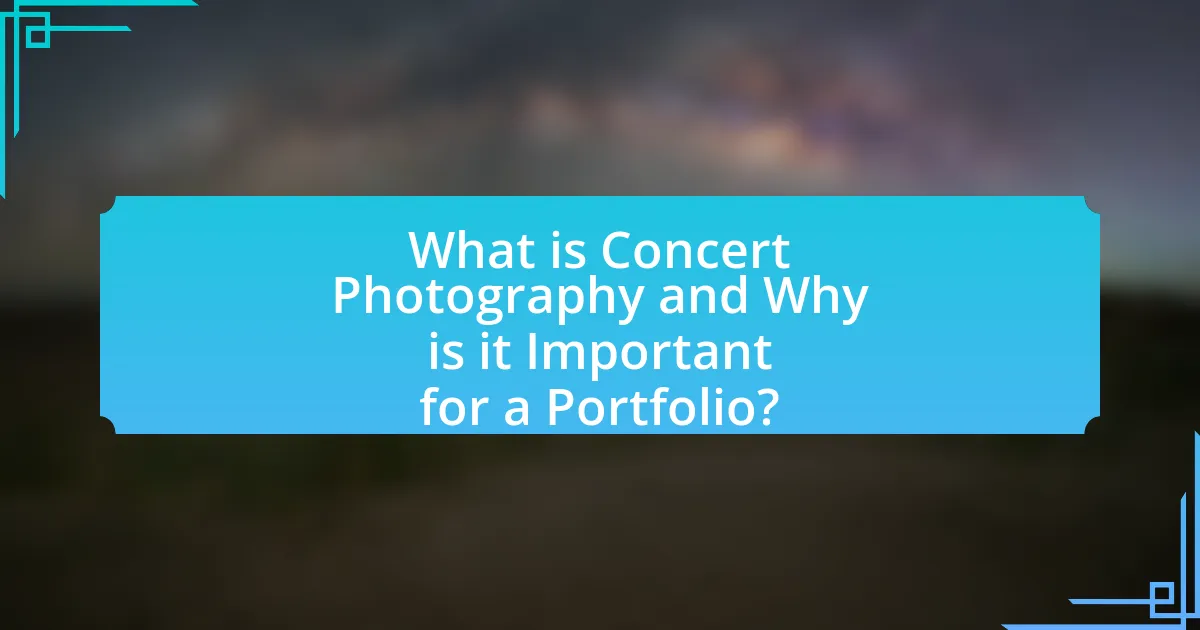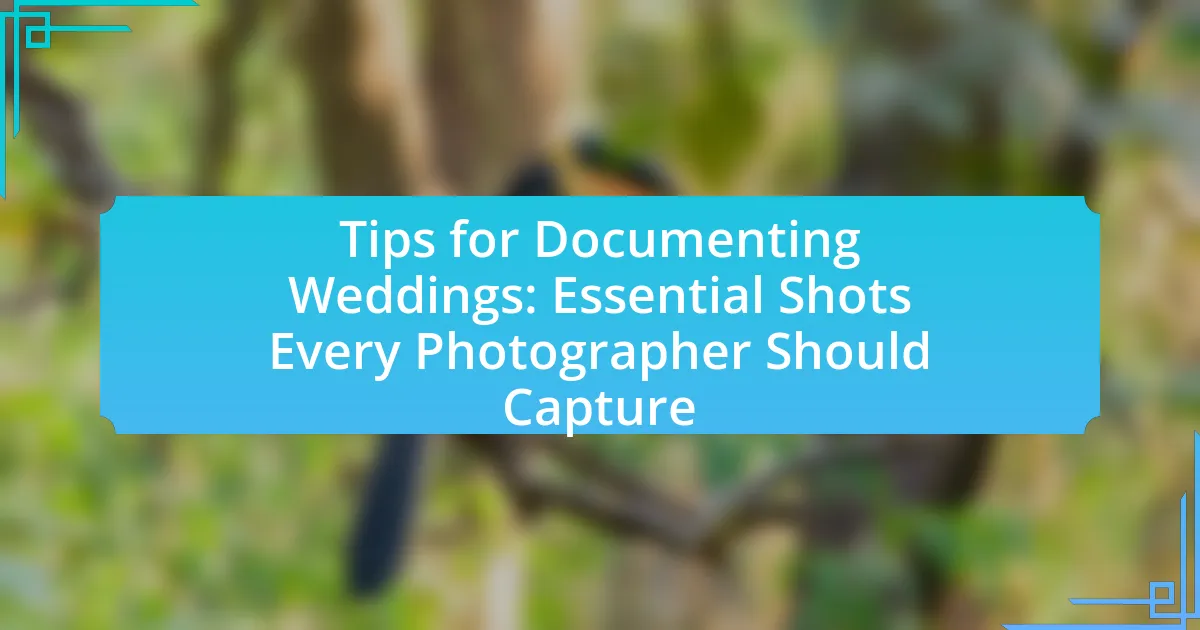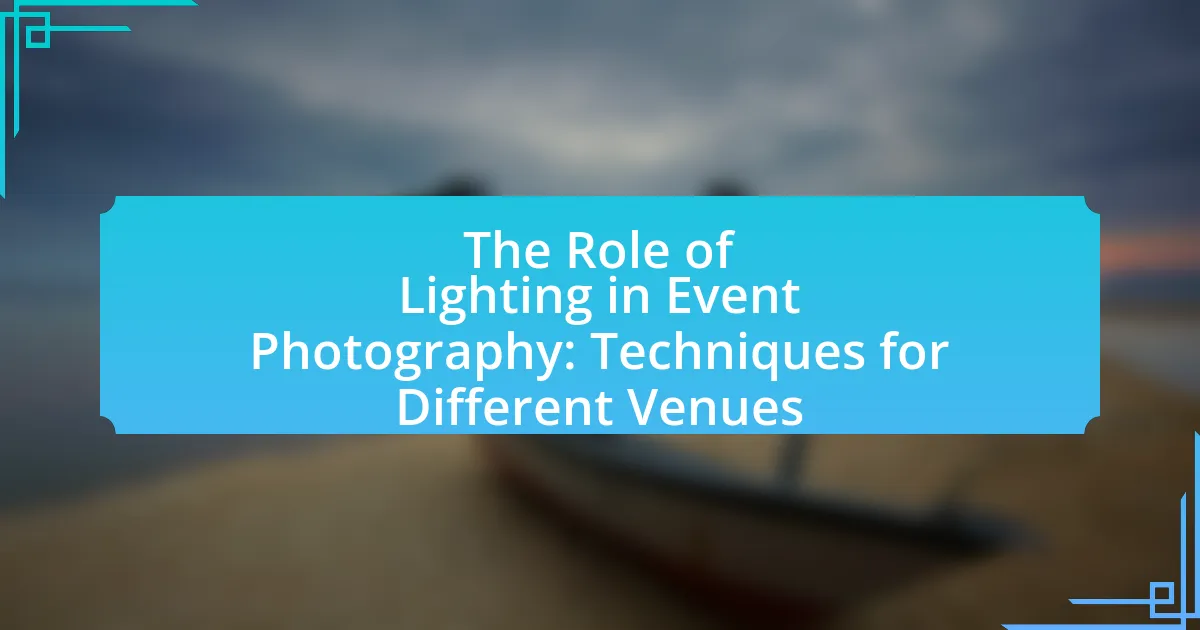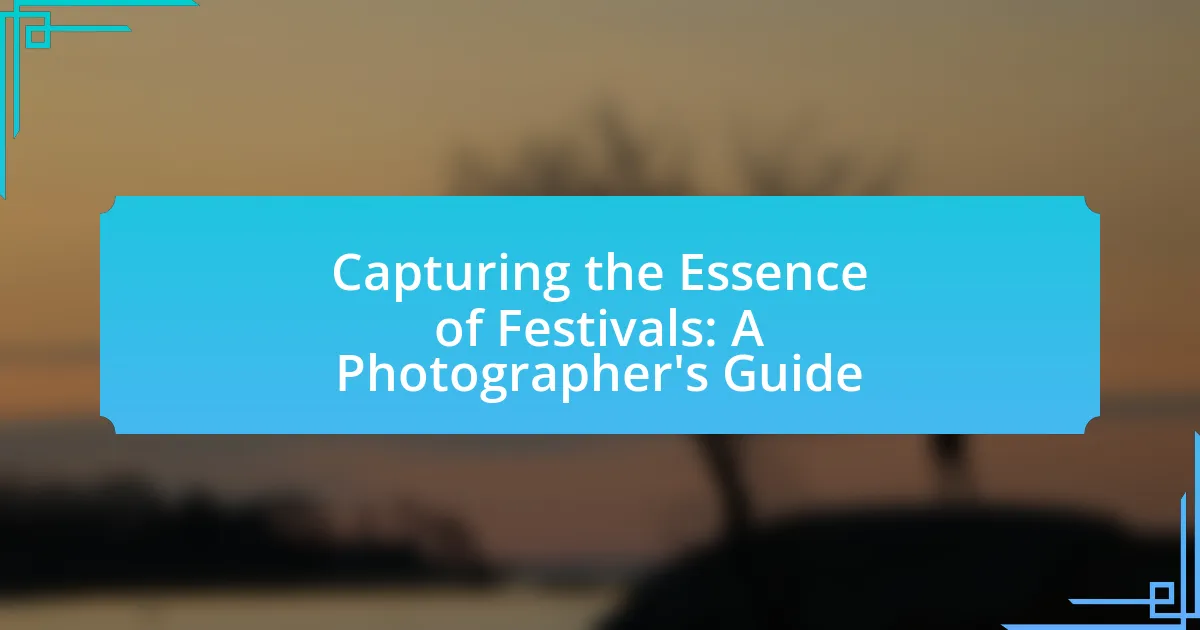Concert photography is a specialized genre that captures the energy and emotion of live music performances, making it a crucial component of a photographer’s portfolio. This article outlines the unique challenges of concert photography, including low-light conditions and fast-paced action, while emphasizing the importance of technical skills and creative composition. It also discusses how to curate a standout portfolio by selecting impactful images, organizing them effectively, and utilizing storytelling techniques to engage viewers. Additionally, the article provides insights into the technical aspects of concert photography, including optimal camera settings and post-processing techniques, as well as best practices for presenting work both online and in physical formats.

What is Concert Photography and Why is it Important for a Portfolio?
Concert photography is the art of capturing live music performances, focusing on the energy, emotion, and atmosphere of the event. This genre is important for a portfolio because it showcases a photographer’s ability to work in dynamic environments, demonstrating skills in low-light conditions, quick reflexes, and an understanding of composition and timing. Additionally, concert photography can highlight a photographer’s versatility and creativity, making it a valuable asset for attracting clients in the music and entertainment industry.
How does concert photography differ from other types of photography?
Concert photography differs from other types of photography primarily due to its dynamic environment, characterized by low light conditions, rapid movement, and the need for quick reflexes. Unlike studio or landscape photography, concert photographers must adapt to unpredictable lighting changes and the fast-paced action of performers, often requiring specialized equipment such as fast lenses and high ISO settings to capture sharp images. Additionally, concert photography emphasizes capturing the energy and emotion of live performances, which involves a unique approach to composition and timing that is distinct from other photography genres.
What unique challenges does concert photography present?
Concert photography presents unique challenges primarily due to variable lighting conditions, fast-moving subjects, and the need for quick decision-making. The lighting at concerts often fluctuates dramatically, requiring photographers to adjust settings rapidly to capture clear images without motion blur. Additionally, performers frequently move around the stage, making it difficult to frame shots effectively. The fast-paced environment demands that photographers make split-second decisions regarding composition and camera settings, which can be further complicated by restrictions on equipment and access to certain areas of the venue. These factors collectively make concert photography a demanding yet rewarding discipline.
How can concert photography showcase a photographer’s style?
Concert photography can showcase a photographer’s style through their unique approach to composition, lighting, and emotion captured in live performances. By selecting specific angles, framing subjects in dynamic ways, and utilizing creative lighting techniques, photographers can express their artistic vision and personal aesthetic. For instance, a photographer who emphasizes dramatic contrasts and vibrant colors may convey a high-energy style, while another who focuses on intimate moments and softer tones might reflect a more subdued, emotional approach. This differentiation is evident in the portfolios of renowned concert photographers, such as Danny Clinch and Annie Leibovitz, who have distinct visual signatures that resonate with their audience and highlight their individual styles.
What elements make a concert photography portfolio stand out?
A concert photography portfolio stands out through a combination of striking imagery, diverse angles, and emotional engagement. Striking imagery captures the energy and atmosphere of live performances, showcasing sharp focus and vibrant colors that reflect the mood of the event. Diverse angles, including close-ups of artists and wide shots of the audience, provide a comprehensive view of the concert experience. Emotional engagement is achieved by capturing candid moments that resonate with viewers, such as expressions of joy or intensity from both performers and fans. These elements collectively enhance the portfolio’s appeal, making it memorable and impactful.
How does the selection of images impact the overall impression?
The selection of images significantly impacts the overall impression by influencing the viewer’s emotional response and perception of quality. High-quality, well-composed images can evoke strong emotions and create a sense of professionalism, while poorly chosen images may detract from the intended message and diminish the viewer’s interest. Research indicates that visual elements account for 93% of a person’s judgment about a product or service, highlighting the importance of image selection in shaping perceptions. In concert photography, selecting dynamic, engaging images that capture the energy of the performance can enhance the portfolio’s appeal and effectively convey the photographer’s style and expertise.
What role does storytelling play in a concert photography portfolio?
Storytelling is essential in a concert photography portfolio as it enhances the emotional connection between the viewer and the images. By capturing not just the performance but also the atmosphere, audience reactions, and behind-the-scenes moments, photographers create a narrative that conveys the experience of the concert. This narrative approach allows viewers to engage with the images on a deeper level, making them feel as if they were part of the event. Research indicates that visual storytelling can increase viewer retention and emotional engagement, which is crucial in a competitive field like concert photography.

How to Curate Your Concert Photography Portfolio?
To curate your concert photography portfolio, select a cohesive collection of your best images that showcase your unique style and technical skills. Focus on including a variety of shots, such as wide-angle crowd scenes, intimate close-ups of performers, and dynamic action shots, to demonstrate versatility. Aim for a balanced representation of different genres and venues to appeal to a broader audience.
Additionally, ensure that each image is of high quality, with proper exposure and composition, as this reflects professionalism. Organize the portfolio in a logical sequence, perhaps chronologically or thematically, to create a narrative flow. Finally, consider seeking feedback from peers or mentors in the photography community to refine your selection and presentation.
What criteria should you use to select images for your portfolio?
To select images for your portfolio, prioritize quality, diversity, and emotional impact. High-quality images showcase your technical skills and attention to detail, while diversity in subjects and styles demonstrates versatility and adaptability in various concert settings. Emotional impact is crucial, as images that evoke feelings can resonate more with viewers, making your portfolio memorable. For instance, a study by the Visual Teaching Alliance highlights that emotionally charged images are more likely to engage audiences, reinforcing the importance of selecting impactful visuals.
How do you determine which concerts to include?
To determine which concerts to include, one evaluates factors such as the artist’s popularity, the venue’s significance, and the overall visual appeal of the performance. Popular artists often attract larger audiences and generate more interest, while iconic venues can enhance the portfolio’s prestige. Additionally, visually captivating performances, characterized by dynamic lighting and engaging stage presence, contribute to a more striking collection of images. This approach ensures that the selected concerts resonate with viewers and showcase a diverse range of experiences in concert photography.
What types of shots should be prioritized in your selection?
In concert photography, the types of shots that should be prioritized include wide shots, close-ups, and candid moments. Wide shots capture the overall atmosphere and stage presence, providing context to the performance. Close-ups focus on the artist’s expressions and emotions, which are crucial for conveying the intensity of the performance. Candid moments highlight interactions between band members or with the audience, adding a dynamic element to the portfolio. Prioritizing these shot types ensures a well-rounded representation of the concert experience, appealing to both fans and industry professionals.
How can you organize your portfolio for maximum impact?
To organize your portfolio for maximum impact, prioritize showcasing your best concert photography first. This approach captures immediate attention and highlights your strongest work. Arrange the images thematically or chronologically to create a narrative flow, allowing viewers to experience the progression of your style and skills. Additionally, include a variety of shots—wide angles, close-ups, and candid moments—to demonstrate versatility. Research indicates that portfolios with a clear structure and diverse content engage viewers more effectively, as evidenced by studies showing that organized presentations lead to higher retention rates and viewer satisfaction.
What are effective ways to categorize your images?
Effective ways to categorize your images include organizing them by event, date, or artist. This method allows for easy retrieval and enhances the viewer’s experience by providing context. For instance, categorizing images by concert date helps in tracking the progression of an artist’s performance style over time, while grouping by artist allows fans to find all related images in one place. Additionally, using tags or keywords related to genres, venues, or themes can further refine the categorization process, making it efficient for both personal use and portfolio presentation.
How does the order of images affect viewer engagement?
The order of images significantly impacts viewer engagement by influencing the narrative flow and emotional response. A well-structured sequence can guide viewers through a visual story, enhancing their connection to the content. Research indicates that images presented in a logical or thematic order can increase retention and emotional resonance, as seen in studies where viewers reported higher engagement levels with curated sequences compared to random arrangements. For instance, a study published in the Journal of Visual Communication found that images arranged to build tension and climax resulted in a 30% increase in viewer interest and recall. Thus, strategically ordering images can effectively enhance viewer engagement in concert photography portfolios.

What Technical Aspects Should You Consider in Concert Photography?
In concert photography, key technical aspects to consider include camera settings, lighting conditions, and lens choice. Proper camera settings, such as a fast shutter speed (1/200s or faster) and a wide aperture (f/2.8 or lower), are essential to capture sharp images in low-light environments typical of concerts. Additionally, understanding the venue’s lighting conditions allows photographers to adjust their ISO settings accordingly, often ranging from 800 to 6400, to maintain image quality without excessive noise. The choice of lens is also critical; a fast prime lens (like a 50mm f/1.8) or a versatile zoom lens (such as a 24-70mm f/2.8) can provide the necessary flexibility and clarity to capture dynamic performances. These technical considerations are vital for producing high-quality images that stand out in a concert photography portfolio.
How do lighting conditions affect your photography choices?
Lighting conditions significantly influence photography choices by determining exposure settings, composition, and the overall mood of the images. For instance, low-light environments, common in concert settings, require photographers to adjust their camera settings, such as increasing ISO or using wider apertures, to capture clear images without motion blur. Additionally, the quality of light, whether harsh or soft, affects how colors and textures are rendered, impacting the visual storytelling of the concert experience. Research indicates that photographers often rely on techniques like using fast lenses or external lighting to adapt to challenging lighting conditions, ensuring that the final images convey the energy and atmosphere of the performance effectively.
What camera settings are optimal for concert environments?
Optimal camera settings for concert environments typically include a wide aperture (f/1.8 to f/2.8) to allow maximum light, a high ISO (800 to 3200) to capture details in low light, and a shutter speed of at least 1/200 seconds to freeze motion. These settings help photographers effectively manage the challenging lighting conditions and fast-paced action often found at concerts. Using a wide aperture enhances subject isolation, while a higher ISO compensates for low light, and a fast shutter speed prevents motion blur, ensuring sharp images.
How can you adapt to changing lighting during a performance?
To adapt to changing lighting during a performance, photographers should utilize manual settings on their cameras to adjust exposure, ISO, and shutter speed in real-time. This allows for immediate responsiveness to fluctuating light conditions, ensuring that images remain well-exposed. For instance, increasing the ISO can help capture details in low-light situations, while adjusting the shutter speed can freeze motion in brightly lit environments. Additionally, using fast lenses with wide apertures enables better performance in varying light. These techniques are supported by the fact that professional concert photographers often rely on their ability to quickly modify camera settings to maintain image quality despite unpredictable lighting changes.
What editing techniques enhance concert photographs?
Editing techniques that enhance concert photographs include adjusting exposure, increasing contrast, and applying color correction. Adjusting exposure helps to balance the brightness of the image, ensuring that details in both highlights and shadows are visible. Increasing contrast enhances the dynamic range, making the image more visually striking by emphasizing the differences between light and dark areas. Color correction is crucial for accurately representing the lighting conditions of the concert, which often includes vibrant stage lights that can distort colors. These techniques collectively improve the overall quality and impact of concert photographs, making them more appealing to viewers.
How can post-processing improve the mood of your images?
Post-processing can significantly enhance the mood of your images by allowing for adjustments in color, contrast, and exposure. These modifications can evoke specific emotions; for instance, warmer tones can create a sense of intimacy, while cooler tones may convey detachment or melancholy. Research indicates that color grading can influence viewer perception, with studies showing that certain color palettes are associated with specific emotional responses. By utilizing tools like Lightroom or Photoshop, photographers can manipulate these elements to align the visual narrative with the intended emotional impact, ultimately making the images more compelling and resonant with the audience.
What common editing mistakes should be avoided?
Common editing mistakes to avoid in concert photography include over-processing images, which can lead to unnatural colors and loss of detail. Additionally, neglecting to maintain consistency in style across the portfolio can create a disjointed viewing experience. Failing to properly crop images can result in distracting elements that detract from the main subject. Lastly, not paying attention to the exposure and contrast can leave images looking flat and unappealing. These mistakes can undermine the overall quality and impact of a concert photography portfolio.
What are the best practices for presenting your portfolio?
The best practices for presenting your portfolio include showcasing high-quality images, organizing content thematically, and providing context for each piece. High-quality images are essential as they reflect your skills and professionalism; for instance, using images with proper lighting and composition can significantly enhance viewer engagement. Organizing content thematically allows viewers to navigate your work easily, making it clear what your focus areas are, such as live performances or artist portraits. Providing context for each piece, such as the story behind the shot or the techniques used, adds depth and demonstrates your thought process, which can resonate with potential clients or employers.
How can you utilize online platforms effectively?
To utilize online platforms effectively for creating a stunning portfolio from concert photography, focus on selecting the right platforms that showcase visual content, such as Instagram, Flickr, and personal websites. These platforms allow photographers to display high-quality images, engage with audiences, and network with industry professionals. For instance, Instagram’s visual-centric design enables photographers to reach a wider audience, with over 1 billion active users, making it a powerful tool for exposure. Additionally, using features like hashtags and geotags can enhance discoverability, leading to increased engagement and potential collaborations.
What physical formats should you consider for showcasing your work?
For showcasing your work in concert photography, consider using high-quality prints, photo books, and framed images. High-quality prints allow for vibrant color reproduction and detail, making them ideal for display in galleries or exhibitions. Photo books provide a curated collection of your best images, offering a tactile experience that engages viewers. Framed images add a professional touch and can enhance the presentation of individual pieces. These formats are widely recognized in the photography community for their effectiveness in showcasing visual art.
What tips can help you create a stunning concert photography portfolio?
To create a stunning concert photography portfolio, focus on showcasing a diverse range of images that highlight different aspects of live performances. Include shots that capture the energy of the crowd, the emotions of the performers, and unique angles that provide a fresh perspective. Use high-quality images with proper exposure and composition to ensure visual appeal. Additionally, curate your selection to feature your best work, ideally 15-20 images, to maintain viewer engagement. Consistency in style and editing will also enhance the overall cohesiveness of the portfolio.
How can networking with musicians and venues enhance your portfolio?
Networking with musicians and venues enhances your portfolio by providing access to diverse opportunities for collaboration and exposure. Engaging with musicians allows photographers to capture unique performances, which can showcase their skills and creativity in dynamic environments. Additionally, building relationships with venues can lead to exclusive access to events, enabling photographers to document a variety of performances and styles. This variety enriches the portfolio, demonstrating versatility and attracting potential clients. Furthermore, musicians and venues often share the work of photographers on their platforms, increasing visibility and credibility within the industry.
What resources are available for continuous improvement in concert photography?
Resources available for continuous improvement in concert photography include online courses, photography workshops, and community forums. Online platforms like MasterClass and Skillshare offer courses specifically focused on concert photography techniques, lighting, and composition. Workshops led by professional concert photographers provide hands-on experience and personalized feedback, enhancing practical skills. Additionally, community forums such as Reddit’s photography subreddits and dedicated Facebook groups allow photographers to share their work, receive critiques, and learn from peers. These resources collectively support ongoing skill development and knowledge sharing in the field of concert photography.

















